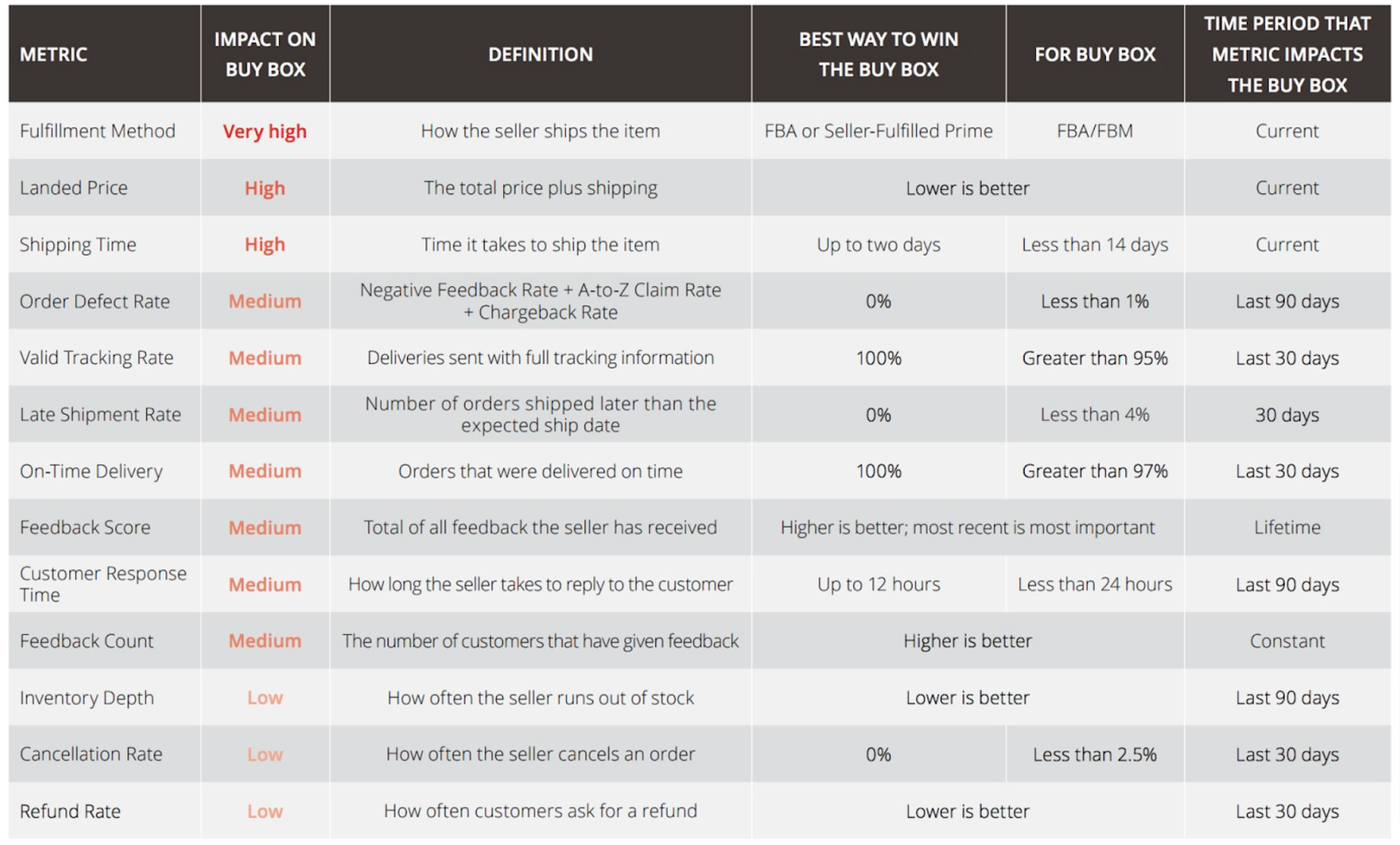Globally, there are nearly two million small and midsize third-party businesses selling on Amazon, with roughly 3,700 new sellers joining the platform every day. If you want your products to rank above the dozens of other businesses in your niche, it’s crucial to understand Amazon’s ranking factors. Once you know which ones contribute to improved rankings (and how), you can optimize your listings to rank higher and earn better results.
Although there are many factors essential to your brand’s success on Amazon — conversions, CTR, relevant keywords, product listing completeness, etc. — some of these should be tackled before others (for example, you need traffic to your listings to improve conversion rates).
This post will focus on KPIs we’ve found to be the most important to track to rank and sell better on Amazon.
5 KPIs to focus on to boost Amazon sales
Key performance indicators, or KPIs, provide valuable insights sellers can leverage to improve their online businesses. They’re a crucial part of your growth strategy on Amazon because they reveal what’s working well with customers and how people interact within the system.
Let’s break down five main KPIs that significantly impact your sales growth as an Amazon seller.
1) Content quality
High-quality product detail pages (PDPs), including images and videos, are the first thing you should consider when differentiating your products and improving your positioning on Amazon. First impressions matter, so your product needs to stand out to generate traffic and growing sales.
Invest more of your time creating unique, high-quality, interesting, and relevant content, and stay up to date with the latest opportunities to enrich your Amazon content.
Here are some concrete ways to maximize your optimized listings:
-
- Employ the most relevant keywords to product titles and bullet points.
- Your product title is the first thing customers see and makes a huge impact on how your product ranks in search results. As such, optimizing your listing (through SEO) should be the first thing you improve to draw more traffic to your product listing.
- Amazon uses the A9 Search Algorithm to best match customer searches to the desired product, and content is an important factor that influences your search ranking results in it.
- Employ the most relevant keywords to product titles and bullet points.
- Publish up-to-date pictures.
-
- Quality images support sales and help build your brand’s perception.
- Aside from general product images, spotlight its critical features, the product in use, and lifestyle images.
- Include award badges to provide additional value for potential customers.
- Showcase videos
-
- Videos help you build relationships with potential customers by putting a face and voice to your brand.
- Effective videos highlight product features and benefits and show their various uses.
- You can add up to six videos to each product page, so you can combine “how to use” and influencer videos with general product videos.
- Add A+ content to present your brand and products as premium and professional.
-
- Amazon asserts sellers can increase sales 10% by educating your customers about your product with A+ content.
- Each section of your landing page sells the next, and all the creatives need to entice the visitor to keep scrolling. A+ content does this best.
To calculate the quality of your content, you can take advantage of numerous tools that’ll review the status of your titles, key points, images, and other elements of the product page to determine which parts of your content should be improved.
2) Reviews
Once you know you have a rich listing and valuable content for your brand, consider your reviews strategy. Amazon reviews are a critical factor of your store’s success; they directly impact conversion rate, rankings, and your sales.
From Amazon Vine to the “Request a review” feature, there are many opportunities to enrich your product pages with customer opinions. We also recommend searching competitors’ reviews to look for common complaints or issues. Avoid the same mistakes and refine your on-page content to surpass customer expectations.
Follow Amazon’s Review Policy to avoid negative repercussions for your store. Some restrictions to be aware of include:
- Posting a review of your own product or a competitor’s product
- Offering a financial reward, discount, free products, or other compensation to a third party in exchange for a review of your or your competitor’s product
- Providing a refund or reimbursement after the buyer writes a negative review and asking them to change or remove the review before or after the reimbursement
- Creating a variation relationship between products to manipulate reviews and boost an item’s star rating via review aggregation
As mentioned earlier, there are two Amazon initiatives sellers can use to increase their reviews:
a) Amazon Vine
This program invites Amazon’s most trusted reviewers to post opinions about new products to help their fellow customers make informed purchase decisions. Amazon invites buyers to become Vine reviewers (also known as Vine Voices) based on the insightfulness of their Amazon purchase reviews.
To be eligible for this program, you need to meet the following criteria:
- Be a Professional Selling Partner
- Register your brand in the Amazon Brand Registry
- Be identified as a brand owner
- Have eligible FBA offers
b) Request a review
- This is an optional way to request reviews from your buyers, found on the Order Details page.
- Sellers can use this feature once per order between five and 30 days after the order delivery date. This ensures customers receive relevant, recent review requests.
When you receive a negative product review, you can contact the customer directly to remedy the issue. Navigate to the Customer Review section on your store’s dashboard. After clicking “Contact Customer,” you’ll be presented with two options:
- Courtesy Refund – Offer a full refund
- Customer Support – Ask the customer for additional details on the order to try and fix the problem
When communicating with customers, always maintain a positive, understanding, and friendly tone.
Once you start collecting customer reviews, you can leverage in various ways them to drive new sales, including:
- Display reviews on your website
- Share them on social media channels
- Familiarize yourself with customer needs and update listings accordingly
- Incorporate your best reviews in your PPC campaigns
To keep an eye on your ratings, you can check your Amazon account or have a review tracking tool manage them for you.
3) Inventory Performance Index
Although Amazon keeps secret the math behind their Inventory Performance Index (IPI), the company does suggest sellers pay special attention to three factors to boost their number:
- In-stock inventory – Avoid stockouts and lost sales
- Excess inventory – Minimize inventory carrying and storage costs
- Stranded inventory – Ensure your products are available for purchase and delivery
If your IPI falls below 350, Amazon will limit your ability to send more inventory and impose a penalty on any excess inventory sitting in Amazon warehouses. You can review your IPI in the Manage Inventory tab.
4) Buy Box percentage
A whopping 83% of Amazon sales go through the Buy Box, so knowing how to win the Buy Box for your products is critical to earn more conversions. Numerous factors affect your chances of winning the Buy Box, including your chosen fulfillment method, total product price, and delivery speed. Check these regularly and make improvements on the most critical variables to increase your Buy Box win rate and, in turn, your sales.
You can find Buy Box metrics on your Seller home page and in Amazon Business reports on the ASIN level or as the average rate of all your listings in a chosen period.
Source: BigCommerce
5) Unit session percentage rate
The unit session percentage rate is the number of units ordered divided by the total number of sessions. So, the greater the percentage, the more sales you’re making.
This metric indicates the quality of your product page and your advertising strategy. You can improve your conversion rate by taking the following steps:
- Include product videos
- Split test to find the perfect product photos and phrasing
- Improve SEO (pay special attention to keywords in your product title and page copy)
- Upgrade your A+ page branding
- Increase the number of reviews and their ratings
- Revise and optimize your PPC activities
Wrapping up — Choose your Amazon KPIs wisely
Simply put, there’s no shortcut to improve your Amazon performance. However, focusing on the KPIs mentioned above will boost your rankings in the Amazon product search algorithm and consequently lead to sales growth.




